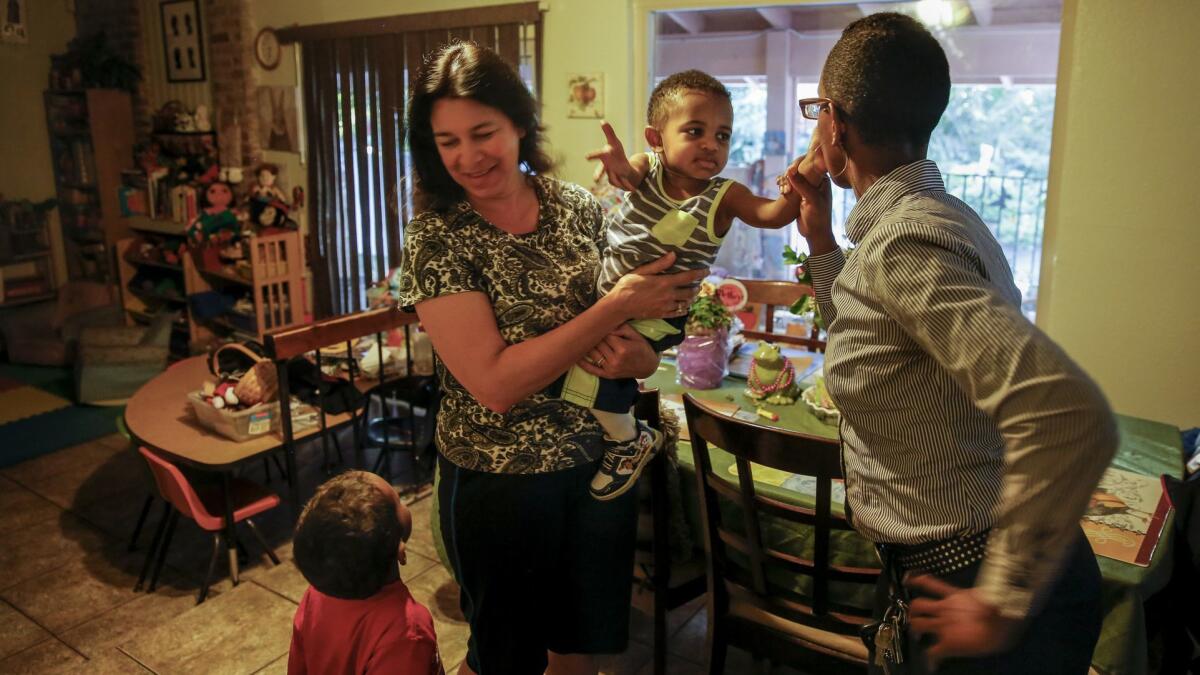California Gov. Gavin Newsom has signed his first budget. Here’s where the $215 billion will go

California will increase its spending on public education, expand healthcare services and stash away more money than ever for an economic downturn under the state budget signed Thursday by Gov. Gavin Newsom — a plan that was stalled for two weeks over how it would address the state’s growing housing crisis.
The $214.8-billion budget is the largest in state history. The majority of its provisions take effect next week, though some new services won’t be funded until January in an effort to lower the short-term cost.
Newsom touted the budget agreement in a live event on Facebook from his Capitol office, reciting a long list of the plan’s highlights and boasting that he had followed the course set by his predecessor, former Gov. Jerry Brown.
“That tradition continues,” Newsom said.
The governor, who took office in January, was largely able to persuade Democrats in the Legislature to follow his lead and expand programs in ways that don’t necessarily commit the state to years of additional spending — ensuring what he called the budget’s “resiliency” to weather future fiscal storms. Perhaps the governor’s largest setback was his effort to impose a new tax on water users for clean water supplies in disadvantaged communities, replaced in the final budget with a plan that relies on funds earmarked for climate change programs.
The governor and Democratic legislative leaders issued only a brief statement in support of the spending plan, a quiet ending to prolonged negotiations after the Legislature agreed to the bulk of the proposal June 13.
Key to those talks was an effort to address the state’s housing and homelessness challenges. Newsom, along with Senate President Pro Tem Toni Atkins (D-San Diego) and Assembly Speaker Anthony Rendon (D-Lakewood), agreed to divvy up $650 million among major cities, counties and regional homelessness prevention agencies, with cities taking the largest share of $275 million. The deal also prioritizes giving state housing funds to cities and counties to make it easier for developers to build. And in the most extreme cases, it would add financial penalties for local governments that violate state laws requiring them to plan for growth.

School spending to rise above an average of $12,000 a student
The new budget sets aside $103.4 billion for education from kindergarten through 12th grade. Schools across California have been clawing their way back from cutbacks made during the last recession, and the fiscal plan pays off $687 million in unsettled education debts, some dating back a decade.
Lawmakers also agreed to an important structural change sparked by those cuts: The state will no longer be able to retroactively lower the mandatory level of education spending — a level set by formulas enshrined by voters in the California Constitution in 1988. In previous years, state budget writers would use such a change to trigger future school spending requirements. Education groups, long angered by the practice, convinced lawmakers to end it.
The budget provides $300 million to expand full-day kindergarten classes across California. And the state will set aside $377 million in a new cash reserve fund, money that can be used when revenues come up short of what’s already been promised to schools.
But while total K-12 spending will hit a record high in the new fiscal year, a number of large school districts continue to struggle with rising financial obligations and stagnant or falling attendance.
California’s education funding is at a record high. So why are schools short on cash? »
Some 15,000 extra spots at UC and Cal State schools, and additional cash grants for students
Lawmakers agreed to boost enrollment at public university and college campuses across the state. The budget waives all fees for up to two years of community college, an expansion of an effort that began in 2017. Additional students will be enrolled on University of California and California State University campuses as well. And more students will be able to lower their tuition costs — the budget includes funding for 41,000 competitive Cal Grant awards.
Students from low-income families will be eligible for additional help in defraying college costs, and some money has been earmarked for students with children and those who attend summer classes. The budget also provides new funds for campus mental healthcare services and to help students who struggle to pay for housing.

Lawmakers put millions into more child-care services
Newsom and legislative leaders agreed to spend $143.3 million to add 12,400 new slots in child-care centers across the state, most of which will be reserved for children from low-income families.
The governor championed a unique way to pay for the expansion: taxes collected from California’s legalized marijuana industry. The budget earmarks $195 million for training child-care workers. An additional $56 million will be spent on child-care services for parents enrolled in the initial stage of the state’s welfare assistance program, CalWorks.
Preschool services will be expanded beginning next April with 10,000 new slots for children. The budget gives priority to working families and those who live in some of the state’s poorest communities.
More Californians will qualify for health insurance subsidies, and everyone is required to have coverage
The new budget’s most sweeping plan aims to shore up the expansion of government-subsidized healthcare that began under the federal Affordable Care Act, a law that’s been shrunk by congressional Republicans and President Trump over the last two years. UC researchers have estimated that absent state action, the number of uninsured Californians will start to rise again over the next few years.
Beginning Jan. 1, Californians will be required to have at least “minimal essential coverage” for healthcare needs or face a cash penalty — a state version of the individual mandate that was abandoned by federal lawmakers. The fines will be based on a person’s income but will range from $695 to $3,252 a year. State officials expect enough people will pay the fine to bring in $317 million in the coming year.
That money, plus additional state tax dollars, will be used to offer new insurance subsidies for middle-class Californians to purchase coverage through the Covered California exchange. Based on federal guidelines, subsidies will be available starting in January to individuals earning up to almost $75,000 a year and families of four earning as much as $154,500. The subsidies to purchase health insurance will be highest for those who earn the least, with the lowest earners eligible for enough financial assistance to pay their entire monthly premiums.

Recession-era cuts to Medi-Cal are restored, and coverage will extend to thousands in the U.S. illegally
California is poised to spend some $36 billion in the new fiscal year on Medi-Cal, the government-funded healthcare system available to those who can’t afford to pay for coverage. The federal government will kick in $64 billion more; estimates show that almost 1 in 3 Californians are eligible for Medi-Cal services.
The budget includes money to restore — at least for the next two years — a variety of services that were deemed nonessential during the recession: optical services, podiatry, help for incontinence issues, audiology and speech therapy. Those services will be available starting Jan. 1.
Medi-Cal eligibility is also being extended to adults in the U.S. illegally through the age of 25. Under that effort, which was championed by Newsom, immigration status won’t be considered for any child or young adult — an expansion of the program that puts California ahead of other states. Democratic lawmakers had wanted to provide access to anyone who meets financial eligibility requirements but lacks legal residency, but Newsom balked over the price tag. Expect those discussions to resume in next year’s state budget talks.

A new monthly tax on California phone service will pay for 911 upgrades
Monthly landline and mobile phone bills will increase slightly Jan. 1, and the budget earmarks that money for improvements to 911 emergency communications across the state.
The exact amount of the surcharge will be set later this year but is initially estimated at 34 cents a month for each phone line. It could ultimately rise to as much as 80 cents a month.
State officials will use the money to speed up California’s transition to what’s known as Next Generation 911, designed with wireless callers in mind and able to transmit additional data including texts and video. Most states are far ahead of California on updating their 911 systems, and lawmakers were warned that the growing threat of deadly wildfires — in addition to earthquake and flood dangers — makes it important to fix the system as soon as possible.
Tax rebates for low-income Californians will be boosted and paid for with higher business taxes
When the federal government enacted a broad overhaul of tax policy in 2017, it meant that a number of California rules were no longer in alignment for taxpayers — the kind of conformity generally applauded for making tax liability more predictable and filing taxes easier.
Changing some of those state taxes — deductions for some large banks and companies, tax breaks for some exchanges of property, and write-offs for some business losses — will bring in $1.6 billion in state revenues. And the budget spends about $1 billion of that on a broad expansion of California’s earned income tax credit, a cash rebate to low-income workers.
Taxpayers who earn up to $30,000 will be eligible for the expanded credit. Also new is a $1,000 tax rebate for low-income families with children under the age of 6. It’s estimated the expanded tax credit could help 3 million households across the state.
One-time payments will shrink future obligations to public employee retirement systems
Newsom and lawmakers agreed to use a portion of the state’s large tax windfall to pay down a portion of the long-term cost of pension and retirement promises made to public employees.
In all, about $9 billion in payments — on top of those already required by law — will be made into the California Public Employees’ Retirement System and the California State Teachers’ Retirement System. Almost half of that amount will be money owed by schools and community colleges on pension costs, with the expectation that help from the state will free up local education dollars for classroom needs or to pay teachers. The remaining amount lawmakers hope, will amount to a prepayment of the state’s future pension obligations.
The state made a similar early payment of its pension obligations in 2017. These costs continue to be a long-term concern for the state and local governments — payments by cities, for example, have been steadily rising after CalPERS officials lowered expectations of future investment profits.
Times staff writer Liam Dillon contributed to this report.
Follow @johnmyers on Twitter and sign up for our daily Essential Politics newsletter
Get the L.A. Times Politics newsletter
Deeply reported insights into legislation, politics and policy from Sacramento, Washington and beyond. In your inbox three times per week.
You may occasionally receive promotional content from the Los Angeles Times.




